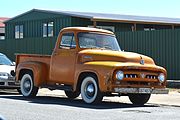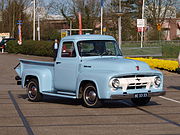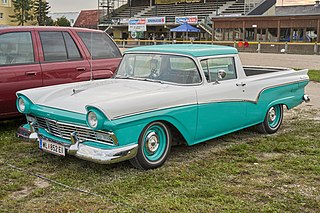
The Ford Ranchero is a coupe utility that was produced by Ford between 1957 and 1979. Unlike a standard pickup truck, the Ranchero was adapted from a two-door station wagon platform that integrated the cab and cargo bed into the body. A total of 508,355 units were produced during the model's production run. Over its lifespan it was variously derived from full-sized, compact, and intermediate automobiles sold by Ford for the North American market.

The Ford Country Squire is a series of full-size station wagons that were assembled by American automaker Ford. Positioned as the top-level station wagon of the Ford division, the Country Squire was distinguished by woodgrain bodyside trim. From 1950 through the 1991 model years, eight generations of the Country Squire were produced. Following the discontinuation of Edsel Bermuda, Mercury marketed the Mercury Colony Park as a divisional counterpart of the Country Squire, sharing bodywork and trim while the Mercury was not available with a six cylinder engine and was more expensive due to the optional equipment on the Ford that was standard on the Mercury.
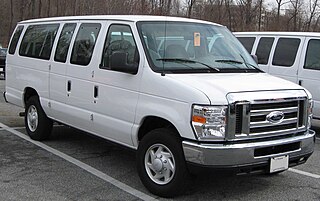
The Ford E-Series is a range of full-size vans manufactured and marketed by the Ford Motor Company. Introduced for 1961 as the replacement of the Ford F-Series panel van, four generations of the model line have been produced. Marketed for both cargo and passenger transport configurations, the E-Series has been designed with multiple design variations for both retail and commercial sale, including vans, and commercial-grade cutaway van chassis and stripped chassis.

The Ford F-Series is a series of light-duty trucks marketed and manufactured by Ford since the 1948 model year. The F-Series is marketed as a range of full-sized pickup trucks positioned above the midsize Ranger but below the larger Super Duty in the Ford truck lineup. Alongside the F-150, the F-Series also includes the Super Duty series, which includes the heavier-duty F-250 through F-450 pickups, F-450/F-550 chassis cabs, and F-600/F-650/F-750 Class 6–8 commercial trucks.

The Ford Super Duty is a series of heavy-duty pickup trucks produced by the Ford Motor Company since the 1999 model year. Slotted above the consumer-oriented Ford F-150, the Super Duty trucks are an expansion of the Ford F-Series range, from F-250 to the F-600. The F-250 through F-450 are offered as pickup trucks, while the F-350 through F-600 are offered as chassis cabs.
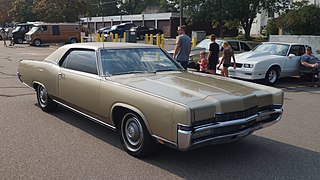
The Mercury Marquis is a model line of automobiles marketed by Mercury from 1967 to 1986. Deriving its name from a title of French nobility, the Marquis was introduced as the divisional counterpart of the Ford LTD; four generations of the two model lines were paired through rebranding. Initially slotted as the flagship Mercury full-size range, the Marquis would serve as the basis for the later Mercury Grand Marquis.

The Chevrolet Kodiak and GMC TopKick are a range of medium-duty trucks that were produced by the Chevrolet and GMC divisions of General Motors from 1980 to 2009. Introduced as a variant of the medium-duty C/K truck line, three generations were produced. Slotted between the C/K trucks and the GMC Brigadier Class 8 conventional, the Kodiak/TopKick were developed as a basis for vocationally oriented trucks, including cargo haulers, dump trucks, and similar vehicles; on later generations, both cutaway and cowled-chassis variants were produced for bus use.

The medium-duty version of the Ford F-Series is a range of commercial trucks manufactured by Ford since 1948. Derived from the smaller F-Series pickup trucks, the medium-duty range is currently in its eighth generation. Initially slotted between the F-Series pickup trucks and the "Big Job" conventionals, later generations were slotted below the L-Series "Louisville" trucks; the last two generations are the largest vehicles produced by Ford since its exit from the heavy-truck segment.

The 1955 Ford is an automobile which was produced by Ford in the United States for the 1955 model year and, in revised form, for the 1956 model year. A new design would be offered in 1957.

The Ford B series is a bus chassis that was manufactured by the Ford Motor Company. Produced across six generations from 1948 to 1998, the B series was a variant of the medium-duty Ford F series. As a cowled-chassis design, the B series was a bare chassis aft of the firewall, intended for bodywork from a second-stage manufacturer. While primarily used for school bus applications in the United States and Canada, the chassis was exported worldwide to manufacturers to construct bus bodies for various uses.

The Chevrolet Van or Chevy Van is a range of vans that was manufactured by General Motors from the 1964 to 1996 model years. Introduced as the successor for the rear-engine Corvair Corvan/Greenbrier, the model line also replaced the panel van configuration of the Chevrolet Suburban. The vehicle was sold both in passenger van and cargo van configurations as well as a cutaway van chassis that served as the basis for a variety of custom applications.

The first generation of the Ford F-Series is a series of trucks that was produced by Ford from the 1948 to the 1952 model years. The introduction of the F-Series marked the divergence of Ford car and truck design, developing a chassis intended specifically for truck use. Alongside pickup trucks, the model line included also panel vans, bare and cowled chassis, and marked the entry of Ford into the medium and heavy-duty truck segment.

The fourth generation of the Ford F-Series is a line of trucks produced by Ford from the 1961 to 1966 model years. Introducing a lower and wider cab over the previous generation, Ford introduced several design changes to the model line. In line with modern pickup trucks, the bed sides, hood line, and window sill were all the same height. Ford returned the F-Series to two headlights.

The fifth generationof the Ford F-Series is a line of pickup trucks and commercial trucks that were produced by Ford from the 1967 to 1972 model years. Built on the same platform as the fourth generation F-Series, the fifth generation had sharper styling lines, a larger cab, and expanded engine options.

The sixth generation of the Ford F-Series, also known as the "dentside Ford" to enthusiasts, is a line of pickup trucks and medium-duty commercial trucks that were produced by Ford Motor Company from the 1973 to 1979 model years. Produced by Ford in North America, Argentina, and Australia, this is the third and final generation of trucks derived from the 1965 Ford F-Series.
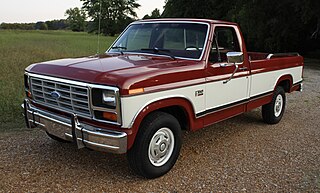
The seventh generation of the Ford F-Series is a range of trucks that was produced by Ford from the 1980 to 1986 model years. The first complete redesign of the F-Series since the 1965 model year, the seventh generation received a completely new chassis and body, distinguished by flatter body panels and a squarer grille, earning the nickname "bullnose" from enthusiasts. This generation marked several firsts for the model line, including the introduction of the Ford Blue Oval grille emblem, the introduction of a diesel engine to the model line, and a dashboard with a full set of instruments (optional). Conversely, this generation marked the end of the long-running F-100, the Ranger trim, and sealed-beam headlamps.

The eighth generation of the Ford F-Series is a line of pickup trucks and light- to medium-duty commercial trucks produced by Ford from 1987 to 1991. While the 1980 cab and chassis was carried over to the new model, the 1987 model was more streamlined, and maintenance items were made simpler. The exterior was facelifted with new composite headlamps, a more aerodynamic front end, and circular fenders. Inside, the interior was given a complete redesign. Rear antilock brakes were now standard, the first pickup truck to boast this. For the first time, all models were produced with straight-sided Styleside beds; the Flareside bed was discontinued except for a small number of early 1987 models using leftover 1986 beds with new circular fenders. In October 1989, Ford premiered the ninth-generation taillights on the last year of the eighth generation.

The first generation of the C/K series is a range of trucks that was manufactured by General Motors from the 1960 to 1966 model years. Marketed by both the Chevrolet and GMC divisions, the C/K trucks replaced the previous Task Force generation of trucks. The first General Motors pickup trucks developed on a dedicated truck platform, the C/K series included pickup trucks, chassis-cab trucks, and medium/heavy commercial trucks.

The second generation of the C/K series is a range of trucks that was manufactured by General Motors. Marketed by both the Chevrolet and GMC divisions from the 1967 to 1972 model years, this generation was given the "Action Line" moniker by General Motors. As with its predecessor, the second generation C/K included full-size pickup trucks, chassis cab trucks, and medium-duty commercial trucks.

The third generation of theC/K series is a range of trucks that was manufactured by General Motors from the 1973 to 1991 model years. Serving as the replacement for the "Action Line" C/K trucks, GM designated the generation under "Rounded Line" moniker. Again offered as a two-door pickup truck and chassis cab, the Rounded Line trucks marked the introduction of a four-door cab configuration.


